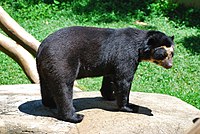
Photo from wikipedia
Grazing areas management is of utmost importance in the Andean region. In the valleys of the Bolivian Cordillera Real near La Paz, pastoralism constitutes the traditional way for people to… Click to show full abstract
Grazing areas management is of utmost importance in the Andean region. In the valleys of the Bolivian Cordillera Real near La Paz, pastoralism constitutes the traditional way for people to insure food security and economical sustainability. In these harsh mountains, unique and productive wetlands sustained by glacial water streams are of utmost importance for feeding cattle herds during the dry season. After the colonization by the Spanish, a shift in livestock species has been observed, with the introduction of exotic species such as cows and sheep, resulting in a different impact on pastures compared to native camelid species—llamas and alpacas. Here we explored some of the social-economical and environmental drivers that motivate Bolivian pastoralists to prefer exotic over native livestock species, based on 36 household surveys in the Cordillera Real. We constructed a Partial Least Squares Structural Equation Model in order to assess the relationships between these drivers. Our results suggest that the access to market influenced pastoralists to reshape their herd composition, by increasing the number of sheep. They also suggest that community size increased daily grazing time in pastures, therefore intensifying the grazing pressure. At a broader scale, this study highlights the effects of some social-economical and environmental drivers on mountain herding systems.
Journal Title: PLoS ONE
Year Published: 2017
Link to full text (if available)
Share on Social Media: Sign Up to like & get
recommendations!